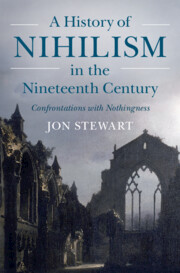Book contents
- A History of Nihilism in the Nineteenth Century
- A History of Nihilism in the Nineteenth Century
- Copyright page
- Dedication
- Contents
- Figures
- Preface
- Acknowledgments
- Introduction
- 1 Jean Paul’s Vision of Nihilism and Plea for the Doctrine of Immortality
- 2 Klingemann and the Absurdity of Nothingness in The Nightwatches
- 3 Nihilism in English Romanticism
- 4 Schopenhauer’s Theory of Human Suffering and Lack of Meaning
- 5 Büchner’s Account of the Reign of Terror as a Mirror of Human Existence
- 6 Poul Martin Møller’s Criticism of Hegelianism and the Danish Discussion of Nihilism
- 7 Kierkegaard and the Indefinability and Inexplicability of Death
- 8 Turgenev’s Portrait of a Nihilist
- 9 Nietzsche’s Vision of the Past and the Future of Nihilism
- 10 The Importance of Nihilism in the Nineteenth Century
- Selected Bibliography on Nihilism
- Name Index
- Subject Index
7 - Kierkegaard and the Indefinability and Inexplicability of Death
Published online by Cambridge University Press: 10 March 2023
- A History of Nihilism in the Nineteenth Century
- A History of Nihilism in the Nineteenth Century
- Copyright page
- Dedication
- Contents
- Figures
- Preface
- Acknowledgments
- Introduction
- 1 Jean Paul’s Vision of Nihilism and Plea for the Doctrine of Immortality
- 2 Klingemann and the Absurdity of Nothingness in The Nightwatches
- 3 Nihilism in English Romanticism
- 4 Schopenhauer’s Theory of Human Suffering and Lack of Meaning
- 5 Büchner’s Account of the Reign of Terror as a Mirror of Human Existence
- 6 Poul Martin Møller’s Criticism of Hegelianism and the Danish Discussion of Nihilism
- 7 Kierkegaard and the Indefinability and Inexplicability of Death
- 8 Turgenev’s Portrait of a Nihilist
- 9 Nietzsche’s Vision of the Past and the Future of Nihilism
- 10 The Importance of Nihilism in the Nineteenth Century
- Selected Bibliography on Nihilism
- Name Index
- Subject Index
Summary
Chapter 7 explores the concept of nihilism in the work of Søren Kierkegaard. While the Danish thinker examines the issue in several different texts, this chapter is confined to his treatments in The Concept of Irony, the “Diapsalmata” from Either/Or, and “At a Graveside” from his collection Three Discourses on Imagined Occasions. In the first work he criticizes the different forms of Romantic irony that can be seen as expressions of nihilism. Kierkegaard’s critical point is that the Romantics offer nothing positive after they have eliminated all truths and values with their negative critique. In the “Diapsalmata” he provides a portrait of the modern nihilist in the aphorisms of the anonymous aesthete. Kierkegaard’s discourse “At a Graveside” focuses on the issue of death and what kind of a disposition one should have towards it. He introduces the concept of the earnestness of death, which means thinking about one’s own demise. He claims that death is both indefinable and inexplicable, and thus it is important not to pretend that we know anything about it. One should thus remain in “the equilibrium of indecisiveness,” although this is difficult.
Keywords
- Type
- Chapter
- Information
- A History of Nihilism in the Nineteenth CenturyConfrontations with Nothingness, pp. 201 - 236Publisher: Cambridge University PressPrint publication year: 2023

